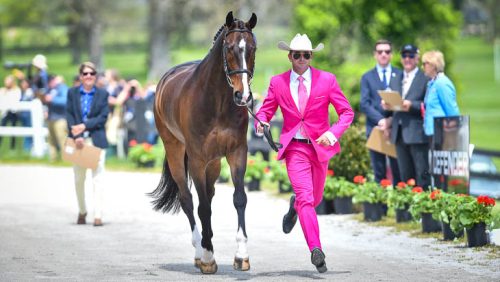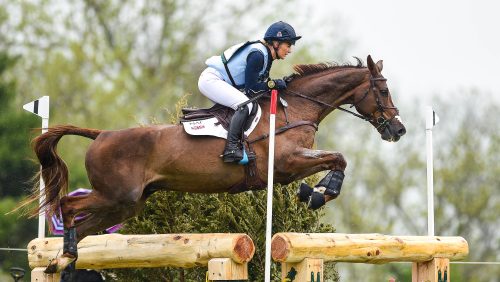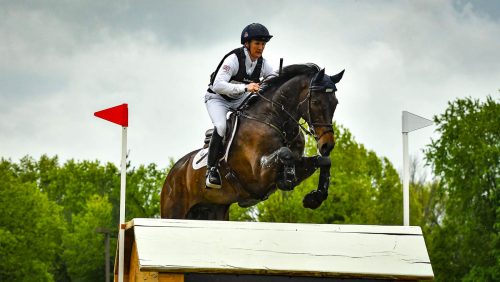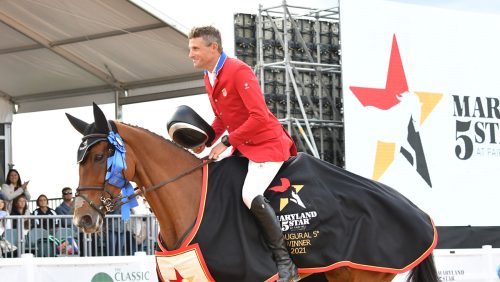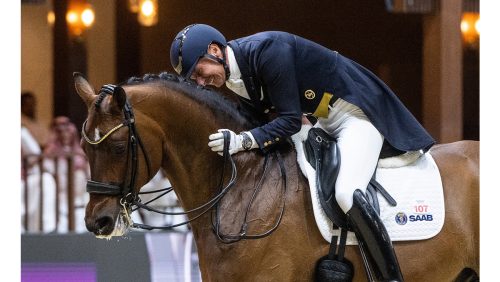I wasn’t much interested in math or science in high school. I wanted to study art and writing; I failed to see the value in taking trigonometry or calculus or chemistry.
Looking back, though, I wish I had paid more attention in physics class. Little did I realize how applicable the laws of science would be to horse sports—particularly when riding in a crowded indoor arena during the winter. There’s nowhere else I can think of where one can observe so many natural laws in action.
The most obvious natural phenomenon is entropy. The concept of entropy maintains that it is natural for things to progress from a state of order, to a state of disorder. Deterioration of order occurs more rapidly within a “closed system”—which in this example is a small, enclosed arena populated by riders of varying ability on horses and ponies that haven’t been turned out in two weeks. The more variables (horses and riders) in the equation (arena), the faster its descent from organization to unholy hell.
At this juncture you may want to assess whether you wish to become one of those variables. Remember the Causality Principle tells us that cause always precedes effect. If you don’t go in to the ring, nothing will happen to you. If you choose to enter, be prepared for the Causality Principle (and likely some tangible objects) to smack you upside the head.
If you decide to take your chances, you’ll find yourself employing the scientific process of using observable data to theorize outcomes. “That grey horse that’s cantering sideways will spook my mare. The out-of-control pony kid will run me into the rail. When my horse gets an eyeful of that sorrel wing-nut being lunged in the corner, he’s going blow a gasket. I’ll get bucked off and trampled.”
Before you overthink it, remember that when two theories predict the outcome of something to the same degree of accuracy, the simpler one is the better one; so in this case you should opt for the more succinct “I’m going to die.” Moreover, additional aspects that do not lend the theory more powerful predicting ability are unnecessary and should be stripped away—meaning that exactly how you die is immaterial; the result is still the same.
ADVERTISEMENT
The chaos in the arena ensues, of course, from a breakdown of the fundamental law of motion. Also referred to as the law of inertia, it states that bodies in motion remain in motion in the same direction and speed unless acted upon by an unbalanced force.
Welcome to the mother lode of unbalanced forces. Your straight, steady ride to the single oxer will be altered by spooking ponies, directionally challenged riders and bolting instructors who are trying to survive a nightmarish, live-action version of the game “Frogger.”
No matter what you’re doing at any given moment, paying attention is critical to your survival, lest you fall victim to pseudoforce. Pseudoforce is a force that arises because an observer is naively treating an accelerating object as an inertial one. Translation: That vaguely equine-shaped chestnut blur is getting larger for a reason. Fail to react in time and you’ll have a ringside seat for one of the primary laws of physics: Two masses cannot occupy the same space at the same time. They can, however, become hopelessly entangled.
Collisions occur because two large, solid objects in proximity to each other will always experience an attractive force. No matter how far away you try to keep your steed from the biggest, craziest horse in the arena, the two will, at some point, end up careening toward each other with apparent disregard for self-preservation.
Dispersion Forces (forces responsible for the non-ideal behavior of things) are also at play here. Dispersion Forces vary according to the Principal of Duality, which states that behavior will differ depending on circumstance. Your horse will be much more likely to volunteer an active canter when you’re pointed at an open gate than when you’re seeking the path of least destruction to the gymnastic.
Behavior may be altered further by high frequency emissions. The introduction of high-frequency sound (for example, you, screaming) makes it possible to experience the Doppler Effect. The frequency of the scream will be higher as it approaches you and lower as it moves away from you. The faster the source of the sound is moving, the more pronounced the effect. Unfortunately, if you’re the one screaming you’ll miss out on the whole fascinating phenomenon.
ADVERTISEMENT
The entropic, closed-system environment of the indoor arena also creates the probability of another anomaly known as Equine Spontaneous Displacement. This is when something startles your horse, causing him to dart in a random direction, and somehow (even though you are astride him and clinging to him) you do not go with him. Equine Spontaneous Displacement is usually followed by Retrograde Inverted Dismount. Predictably, this chain of events concludes with a vivid demonstration of another law of motion: a body at rest tends to remain at rest, particularly after it has impacted a solid object. Say, the ground.
And since, according to the Uncertainty Principle, position and momentum cannot be determined to infinite accuracy—your guess as to where your horse went after he dumped you and galloped out of the ring is as good as anybody’s.
From your private room in the ICU, you can round out your education with one final observation: A body in isolation has no inertia.
Those of you currently studying physics may wish to keep a copy of this column as a handy reference. When the professor asks for a real-life example of Newton’s Second Law—BOOM, you’ve got one. And make an effort to pay attention. Next time you find yourself in that tiny, crowded indoor arena, you may be glad you did.
After years of trying to fit in with corporate America, Jody Lynne Werner decided to pursue her true passion as a career rather than a hobby. So now, she’s an artist, graphic designer, illustrator, cartoonist, web designer, writer and humorist. You can find her work on her Misfit Designs Cafepress site. Jody is one of the winners of the Chronicle’s first writing competition. Her work also appears in the 2013 and 2014 Amateur Issue print editions of The Chronicle of the Horse.







